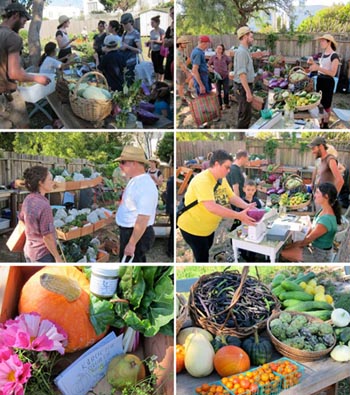
An ordinance passed by the San Francisco Board of Supervisors and signed into law by Mayor Ed Lee last year has provided a green light to urban farms such as Little City Gardens (pictured above), to produce and vend locally grown fruits and vegetables. Photo courtesy Little City Gardens.
By Catherine Adams, guest contributor
January 27, 2012
San Francisco took a bold step in 2011 further legitimizing urban agriculture in the city. With the passage of the Planning Code Amendment on Urban Agriculture (ordinance 66-11), commercial garden and small farm sites are now legal city-wide. The ordinance received unanimous support from the Board of Supervisors in April before it was approved by Mayor Ed Lee.
This ordinance allows properly permitted and code-abiding gardeners and farmers to sell any produce they grow directly to the public on site. Growers were previously required to haul their bounty to a third party commercial zone, like a farmers market, or sell through a distributor. The permit does not, however, allow for value-added products, such as pickles or jam, or animal products, such as honey and eggs, to be sold at garden sites in residential areas. These products can, however, be sold on production sites within commercial zones. Growers can apply for a permit through the Planning Department for approximately $350.
While the ordinance makes it legal to sell produce directly from a production site, according to Diego R. Sánchez of the city Planning Department, only one application for the new permit has been filed so far. Some growers, however, can start selling produce without a permit. Under the new ordinance, a permit is only required if commercial production is the principle use of the site. Gardeners growing produce primarily for personal use do not need to apply for the new permit.
At the December 2011 year-end meeting of the advocacy group San Francisco Urban Agriculture Alliance (SFUAA), coordinators Eli Zigas, Antonio Roman-Alcalá, and Dana Perls agreed that the greatest impact of the ordinance may not be in the number of hobby gardeners turned professional farmers, but the creation of model policy. With the passage of the ordinance, San Francisco is now “the first place in the country that mentions the sale of value added goods on site,” according to Zigas.
“SFUAA get emails from folks all over the bay area and the entire country – Oakland, Burlington, [Washington] D.C., Chicago – all actively seeking information. That’s perhaps biggest change since ordinance passed – visibility,” notes Dana Perls, also of SFUAA. “This [ordinance] has created a lot more discussion….and you see more active farmers speaking out for what they want to see happen. You have people who are impacted by the policy stepping up to take an active role in shaping what that looks like.”
The SFUAA advocates for greater legitimacy and city support of urban agriculture. The organization was instrumental in organizing support for the April 2011 ordinance. To further the growth of urban agriculture in the city, Perls said that the SFUAA “would like the city to take a big step in helping make this vision happen” and emphasized the importance of institutional support and resources. “I’d also love to see more people selling what they grow and taking advantage of the new law,” added Zigas.
SFUAA has published a comprehensive guide to help new gardeners or farmers plan and implement their first urban agriculture site – with or without the intention of selling any produce. Starting a Garden or Urban Farm in San Francisco includes the down and dirty on how to find an appropriate site. The guide also includes more detailed information on creating and maintaining a garden site, such as information on water conservation, soil testing, and how an existing garden or farm site can apply for a change of permit to allow for on-site sale of produce. A listing of existing city offices and resources useful to either new or experienced urban gardeners is included in the guide.


 The Hunger Site
The Hunger Site
January 31, 2012 at 11:16 am
One of Occupy’s sustainable directions.